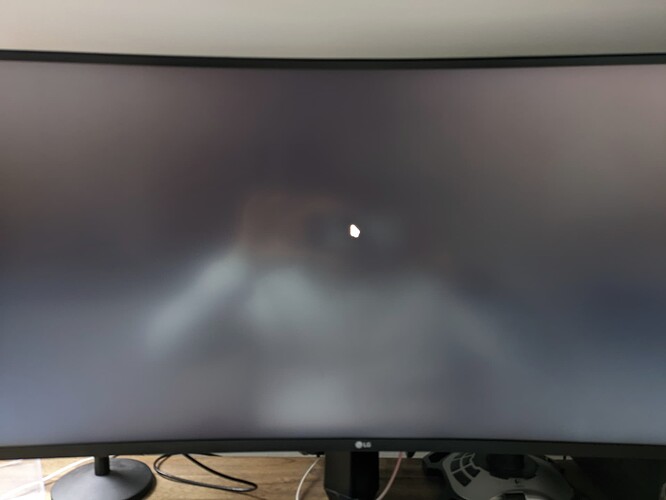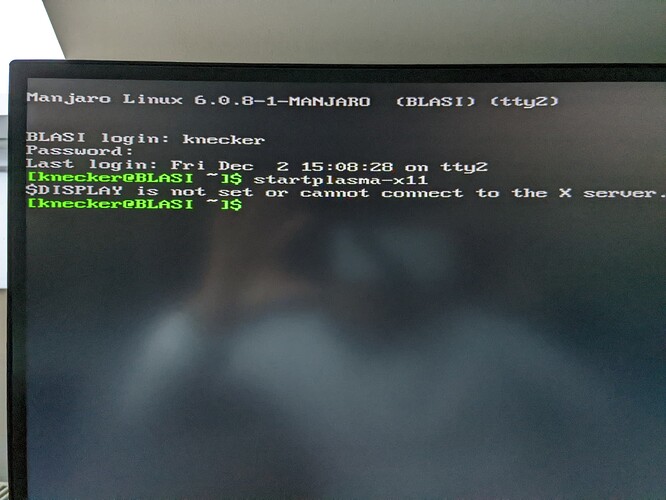Hi fellow Manjarees,
I know there are some rare occasions of users being troubled with machines not responding after a suspended session.
The bug I encounter on Manjaro running KDE latest, is different … and worse: Every time, the display turns off for energy saving (not sleep or hibernation of the system), it does not turn back on again. Once I give an input (mouse movement or key press), the monitor does actually wake up and gets a signal (switches from red standby LED back to blue power LED), but the screen just stays black.
I can, however, switch to a terminal via ctrl+alt+F2 and manually reboot the system.
This bug is severe, for it renders the whole system useless. All open work is lost, once I turn my back on the computer for a couple of minutes. Disabling energy saving is also not an alternative, obviously, just a temporary workaround.
For a beginning, this is my configuration
$ inxi -mFxxxzzz
System:
Kernel: 6.0.8-1-MANJARO arch: x86_64 bits: 64 compiler: gcc v: 12.2.0
Desktop: KDE Plasma v: 5.26.3 tk: Qt v: 5.15.7 info: latte-dock wm: kwin_x11
vt: 1 dm: SDDM Distro: Manjaro Linux base: Arch Linux
Machine:
Type: Desktop System: Micro-Star product: MS-7C84 v: 1.0
serial: <superuser required>
Mobo: Micro-Star model: MAG X570 TOMAHAWK WIFI (MS-7C84) v: 1.0
serial: <superuser required> UEFI: American Megatrends v: 1.51
date: 11/16/2020
Battery:
Device-1: hidpp_battery_0 model: Logitech MX Keys Wireless Keyboard
serial: <filter> charge: 100% (should be ignored) rechargeable: yes
status: discharging
Memory:
RAM: total: 31.27 GiB used: 3.28 GiB (10.5%)
RAM Report: permissions: Unable to run dmidecode. Root privileges
required.
CPU:
Info: 6-core model: AMD Ryzen 5 3600 bits: 64 type: MT MCP smt: enabled
arch: Zen 2 rev: 0 cache: L1: 384 KiB L2: 3 MiB L3: 32 MiB
Speed (MHz): avg: 2421 high: 3600 min/max: 2200/4208 boost: enabled cores:
1: 2200 2: 3600 3: 2200 4: 2200 5: 2200 6: 2200 7: 3600 8: 2200 9: 2055
10: 2200 11: 2200 12: 2200 bogomips: 86441
Flags: avx avx2 ht lm nx pae sse sse2 sse3 sse4_1 sse4_2 sse4a ssse3 svm
Graphics:
Device-1: NVIDIA GA104 [GeForce RTX 3070] vendor: ZOTAC driver: nvidia
v: 520.56.06 arch: Ampere pcie: speed: 16 GT/s lanes: 16 bus-ID: 2d:00.0
chip-ID: 10de:2484 class-ID: 0300
Display: x11 server: X.Org v: 21.1.4 with: Xwayland v: 22.1.5
compositor: kwin_x11 driver: N/A display-ID: :0 screens: 1
Screen-1: 0 s-res: 3840x1600 s-dpi: 109 s-size: 894x372mm (35.20x14.65")
s-diag: 968mm (38.12")
Monitor-1: DP-4 pos: primary res: 3840x1600 dpi: 111
size: 880x370mm (34.65x14.57") diag: 955mm (37.58") modes: N/A
Monitor-2: HDMI-0 size-res: N/A modes: N/A
API: OpenGL v: 4.6.0 NVIDIA 520.56.06 renderer: NVIDIA GeForce RTX
3070/PCIe/SSE2 direct render: Yes
Audio:
Device-1: Creative Labs Sound Core3D [Sound Blaster Recon3D / Z-Series]
driver: snd_hda_intel v: kernel pcie: speed: 2.5 GT/s lanes: 1
bus-ID: 25:00.0 chip-ID: 1102:0012 class-ID: 0403
Device-2: NVIDIA GA104 High Definition Audio vendor: ZOTAC
driver: snd_hda_intel v: kernel pcie: speed: 16 GT/s lanes: 16
bus-ID: 2d:00.1 chip-ID: 10de:228b class-ID: 0403
Sound API: ALSA v: k6.0.8-1-MANJARO running: yes
Sound Server-1: JACK v: 1.9.21 running: no
Sound Server-2: PulseAudio v: 16.1 running: yes
Sound Server-3: PipeWire v: 0.3.59 running: yes
Network:
Device-1: Intel Wi-Fi 6 AX200 driver: iwlwifi v: kernel pcie: speed: 5 GT/s
lanes: 1 bus-ID: 28:00.0 chip-ID: 8086:2723 class-ID: 0280
IF: wlo1 state: up mac: <filter>
Bluetooth:
Device-1: Intel AX200 Bluetooth type: USB driver: btusb v: 0.8 bus-ID: 1-4:3
chip-ID: 8087:0029 class-ID: e001
Report: rfkill ID: hci0 rfk-id: 0 state: up address: see --recommends
Drives:
Local Storage: total: 2.96 TiB used: 556.18 GiB (18.4%)
ID-1: /dev/nvme0n1 vendor: Samsung model: SSD 970 EVO Plus 1TB
size: 931.51 GiB speed: 31.6 Gb/s lanes: 4 type: SSD serial: <filter>
rev: 2B2QEXM7 temp: 26.9 C scheme: GPT
ID-2: /dev/nvme1n1 vendor: Samsung model: SSD 970 EVO Plus 250GB
size: 232.89 GiB speed: 31.6 Gb/s lanes: 4 type: SSD serial: <filter>
rev: 2B2QEXM7 temp: 41.9 C scheme: GPT
ID-3: /dev/sda vendor: Samsung model: SSD 870 QVO 2TB size: 1.82 TiB
speed: 6.0 Gb/s type: SSD serial: <filter> rev: 2B6Q scheme: GPT
Partition:
ID-1: / size: 227.88 GiB used: 78.37 GiB (34.4%) fs: ext4
dev: /dev/nvme1n1p2
ID-2: /boot/efi size: 299.4 MiB used: 288 KiB (0.1%) fs: vfat
dev: /dev/nvme1n1p1
Swap:
Alert: No swap data was found.
Sensors:
System Temperatures: cpu: 47.4 C mobo: N/A gpu: nvidia temp: 49 C
Fan Speeds (RPM): N/A gpu: nvidia fan: 0%
Info:
Processes: 303 Uptime: 24m wakeups: 6 Init: systemd v: 251
default: graphical Compilers: gcc: 12.2.0 clang: 14.0.6 Packages: 1595
pm: pacman pkgs: 1572 pm: flatpak pkgs: 15 pm: snap pkgs: 8 Shell: Bash
v: 5.1.16 running-in: konsole inxi: 3.3.23
Any ideas, where to start bugfixing?

